
April 30 deadline to apply for Tremont Writers Conference
Frank X Walker and David Brill share a fascination with the Great Smoky Mountains. One

Frank X Walker and David Brill share a fascination with the Great Smoky Mountains. One
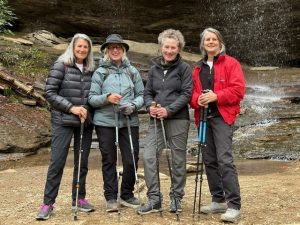
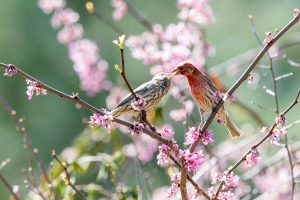
As the days grow warmer and the landscape ripples with color, a growing treetop chorus

Two decades ago, thousands of flies, bugs, and beetles met their end in insect traps

In the heart of Great Smoky Mountains National Park, the arrival of spring unveils a
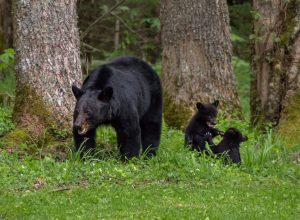
As days lengthen and temperatures rise, black bears begin to move around in the woods searching for insects, nuts, and berries. They also look for food in the gateway communities outside Great Smoky Mountains National Park.
In sync with bears’ emergence, Great Smoky Mountains Association has just released a new book teaching kids the importance of bears’ natural foods and showing what can happen when bears are allowed access to the food humans eat or the scraps and trash those foods create.
Mabel Meets a Black Bear is written for children ages 5 through 10 to read with their parents and grandparents. Its main characters are twin girls who are vacationing with their mom and dad in a Smokies rental cabin near the park. Mabel is extroverted, her inquisitive mind moving so fast that her 10-year-old body can barely keep up. Louise is the narrator, an equally intelligent but quieter, less confident version of her sister.
When Mabel coerces Louise to join her in sneaking out of the cabin in the middle of the night, the two come face-to-face with a large bear that has been lured by snacks Mabel left out on the picnic table. The events that unfold teach the sisters a hard lesson.
Like my first kids’ book, A Search for Safe Passage (GSMA 2021), Mabel was spawned by a colleague’s request and a need for education.
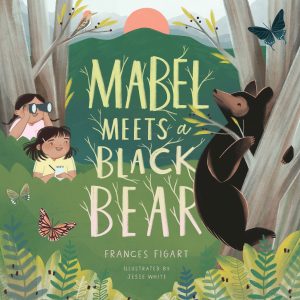
Back in September of 2021, the Smokies BearWise® task force was meeting via Zoom, talking about the dire need to better educate tourists staying in rental cabins. These folks often arrive in the Smokies hoping to see bears but with no understanding that leaving food and trash available to bears can end in their demise.
On a private message in the Zoom chat, Jeff Hunter, Southern Appalachian Director with National Parks Conservation Association, offhandedly wrote: “We need a children’s book about BearWise!” I laughed it off, but that night I found myself unable to ignore a phrase that kept coming into my mind, spoken in a kind of annoyed, scratchy, little-kid voice, “It was my sister Mabel…” Where was this coming from, and who was saying it?
I asked myself, If I were going to tell a story that would teach young people about BearWise, what would that sound like? I knew the main lesson kids (and their adults) need to learn is: When bears become food conditioned due to human behavior, they can end up hurting humans (often by accident), which then leaves wildlife managers no choice but to destroy the animals.
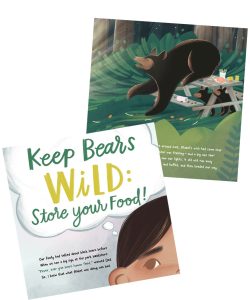
Lest you be thinking the “conflict bears” can just be moved somewhere else, it’s important to hear what wildlife managers have to say: “Though once thought to be an effective method of managing food-conditioned bears, relocation can prove fatal for bears,” says GSMNP Supervisory Wildlife Biologist Bill Stiver. “In a study of 32 GPS-collared bears relocated between 2015 and 2021, 62 percent were either harvested, killed on roads, or euthanized for causing conflict at their new location, while 22 percent simply returned to the original site.”
With all this in mind that evening after the BearWise meeting, I invoked a personal experience from childhood as a way to help me find my characters. Growing up in Eastern Kentucky, I liked to stay all night with my best friend Mary, who lived on a farm a mile off the county road. Farm chores demanded that Mary awake before dawn and go to bed before sunset. But when I came for a sleepover, I would force her to wake up in the middle of the night, and we would sneak out to see the moon, visit the chickens in their coop, and even ride the tame older calves in the warm, starry nights of summer.
“It’s time to get up,” a voice close to me said
I squinted and saw someone next to my bed.
It was my sister Mabel, lit up by the moon
And I knew she was waking me up way too soon.
Using this experience as a way to create a human–bear conflict scenario, I composed the entire rhyming verse of Mabel Meets a Black Bear in about a two-and-a-half-hour window, leaving it to “set up” overnight and returning to it in the morning to perform a few edits. And that was that. The real fun would begin some months later when GSMA’s Design Team Manager Karen Key and I would get to direct the work of our wonderful illustrator, Jesse White of Durham, North Carolina, for a whole year!
We also collaborated to vet both the text and illustrations with NPS’s Stiver, Kim Delozier of BearWild, Dana Dodd of Appalachian Bear Rescue, and the national BearWise message coordinators, LaVonne Ewing and Linda Masterson, who penned the “Be a BearWise Kid” section that follows the story.
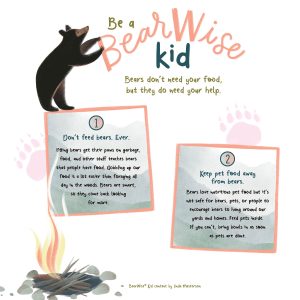
Reps from big companies like Barnes & Noble and REI interested in selling Mabel told us that loss, death, and grief are trending themes right now in books targeted for young readers. That was a relief because, however fun the rhyming verse and however engaging the whimsical illustrations, I know the subject matter of a bear having died and leaving orphaned cubs is very difficult. Yet, without showing the extreme of what can happen when people make their food and scraps available to black bears, I would have missed the mark of educating kids and their families about the gravity of this situation.
With help from their parents and a wildlife biologist named Kevin, Mabel and Louise learn that human actions can mean death for bears who become food conditioned. At the end of the book, we see the twins 17 years later, each having found her own way to educate others “about keeping all food scraps away from black bears.”
Mabel Meets a Black Bear is about the intersection of people and bears in the Smokies, but its lesson applies to wildlife and people near parks and other protected lands everywhere. For human safety, economic stability, and to protect an iconic life form not just in the Smokies but throughout its territory, we need to stop the intentional and unintentional feeding of black bears in developed areas. Lodgings and businesses near protected lands are critical to modeling proper management of food and garbage. My hope is that many of these will purchase Mabel to share with the families who stay in gateway communities.
The Smokies BearWise task force is now partnering with the City of Gatlinburg to raise awareness of the BearWise Basics and to extend its existing ordinance on bear-resistant trash containers to encompass areas outside the current ordinance zone. With Gatlinburg leading the way, the hope is that other park gateway communities will adapt the same policies and ordinances.
Get all the BearWise Basics at bearwise.org.
The Great Smokies Welcome Center is located on U.S. 321 in Townsend, TN, 2 miles from the west entrance to Great Smoky Mountains National Park. Visitors can get information about things to see and do in and around the national park and shop from a wide selection of books, gifts, and other Smokies merchandise. Daily, weekly, and annual parking tags for the national park are also available.